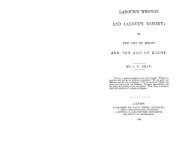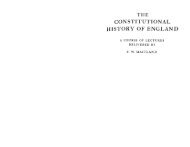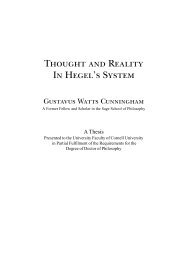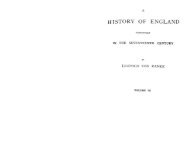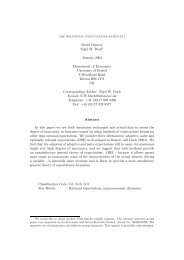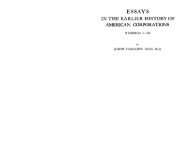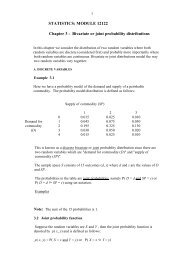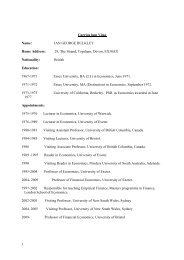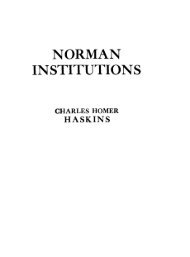PROFESSIONS 237PROFESSIONSIntroductory-Tendencies similar to those in Industry.-Army-Church-Lawclosed to <strong>women</strong>. Teaching-Nursing-Medicine chiefly ~ractised by <strong>women</strong>as domestic arts. Midwifery.(A): Nursinp. The sick poor nursed in lay institutions-LondonHospitals-Dublin-Supplied by low class <strong>women</strong>-Women searchers forthe plague--Nurses for small-pox or plague-Hired nurses in private families.(B) Medrcrrie. Women's skill in Middle ages- Medicine practised extensivelyby <strong>women</strong> in <strong>seventeenth</strong> <strong>century</strong> in their families, among their friendsand for the poor-Also by the village wise woman for pay-Exclusiveness <strong>of</strong>associations <strong>of</strong> physicians, surgeons and apothecaries.(C) MidwifPry. A woman's pr<strong>of</strong>ession-Earlier history unknown-Raynold's translation <strong>of</strong> " the byrthe <strong>of</strong> n1ankynd."-Relative dangers <strong>of</strong>child-birth in <strong>seventeenth</strong> and twentieth centuries-Importance <strong>of</strong> midwives--Character <strong>of</strong> their training-Jane Sharp-Nicholas Culpepper-Peter Chamberlain-Mrs.Cellier's scheme for training-Superiority <strong>of</strong> French training-Licences <strong>of</strong> Midwives-Attitude <strong>of</strong> the Church to them-Fees-Growkgtendency to displace midwives by Doctors.Conclusion. Women's position in the arts <strong>of</strong> teaching and healing lost as thesearte became pr<strong>of</strong>escional.Introductory.SIMILAR tendencies to those which affected theindustrial position <strong>of</strong> <strong>women</strong> can be traced in thepr<strong>of</strong>essions also, showing that, important as was theinfluence <strong>of</strong> capitalistic organisation in the history <strong>of</strong><strong>women</strong>'s evolution, other powerful factors were <strong>working</strong>in the same direction.Three pr<strong>of</strong>essions were closed to <strong>women</strong> in the<strong>seventeenth</strong> <strong>century</strong>, Arms, the Church and the Law.The Law.-Itmust be remembered that the mass <strong>of</strong>the" common people " were little affected by " the law"before the <strong>seventeenth</strong> <strong>century</strong>. " common law "was the law <strong>of</strong> the nobles,' while farming people andl Holdswortb, Vol. III., p. 408.artizans alike were chiefly regulated in their dealingswith each other by c;stoms depending for interpretationand sanction upon a public opinion whichrepresented <strong>women</strong> as well as men. Therefore thechanges which during the <strong>seventeenth</strong> <strong>century</strong> wereabrogating customs in favour <strong>of</strong> common law, didin effect eliminate <strong>women</strong> from what was equivalentto a share in the custody and interpretation <strong>of</strong> law,which henceforward remained exclusively in the hands<strong>of</strong> men. The result <strong>of</strong> the elimination <strong>of</strong> the feminineinfluence is plainly shown in a succession <strong>of</strong> laws,which, in order to secure complete liberty to individualmen, destroyed the collective idea <strong>of</strong> the family, anddeprived married <strong>women</strong> and children <strong>of</strong> the propertyrights which customs had hitherto secured to them.From this time also the administration <strong>of</strong> the lawbecomes increasingly perfuncto~y in enforcing the fulfilment<strong>of</strong> men's responsihilities to their wives andchildren.Chzrrch.-According to modern ideas, religionpertains more to <strong>women</strong> than to men, but this conceptionis new, dating from the scientific era.Science has solved so many <strong>of</strong> the problems whichin former days threatened the existence <strong>of</strong> mankind,that the " man in the street " instinctively relegatesreligion to the region in which visible beauty, poetryand music are still permitted to linger ; to the ornamentalsphere in short, whither the Victorian gentlemanalso banished his wife and daughters. Thisattitude forms a singular contrast to the ideas whichprevailed in the Middle Ages, when men believedthat supernatural assistance was their sole protectionagainst the " pestilence that walketh in darkness "or from " the arrow that flieth by day." Religion wasthen held to be such an awful power that there weremen who even auestioned whether <strong>women</strong> could.properly speaking: be considered religious at all:Even in the <strong>seventeenth</strong> <strong>century</strong> the practice <strong>of</strong>
238 PROFESSIONS PROFESSIONS 239religion and the holding <strong>of</strong> correct ideas concerningit were deemed to be essential for the maintenance<strong>of</strong> human existence, and no suggestion was thenmade that religious observances could be adequatelyperformed by <strong>women</strong> alone.Ideas as to the respective appropriateness <strong>of</strong>religious power to men and <strong>women</strong> have differedwidely ; some races have reserved the priesthood formen, while others have recognised a special powerenduing <strong>women</strong> ; in the history <strong>of</strong> others again nouniform tendency is shown, but the two influences canbe traced acting and reacting upon each other.This has been the case with the Christian religion,which has combined the wide-spread worship <strong>of</strong> theMother and Child with a passionate splitting <strong>of</strong> hairsby celibate priests in dogmatic controversies concerningintellectual abstractions. The worship <strong>of</strong>the Mother and Child had been extirpated in Englandbefore the beginning <strong>of</strong> the <strong>seventeenth</strong> <strong>century</strong> ;pictures <strong>of</strong> this subject were denounced because theyshowed the Divine Son under the domination <strong>of</strong> awoman. One writer accuses the Jesuits <strong>of</strong> representingChrist always " as a sucking child in hismothers armes "-" nay, that is nothing they makehim an underling to a woman," alleging that " theJesuits assert (I) no man, but a woman did helpeGod in the work <strong>of</strong> our Redemption, (2) that Godmade Mary partaker and fellow with him <strong>of</strong> hisdivine Majesty and power, (3) that God hath dividedhis Kingdom with Mary, keeping Justice to himselfe,and yielding mercy to her."He complains thzt" She is always set forth as a woman and a mother,and he as a child and infant, either in her armes,or in her hand, that so the common people mighthave occasion to imagine that looke, what power <strong>of</strong>overruling and commanding the mother hath overher little child, the same hath she over her son Jesus. . . . the mother is compared to the son, notas being a child or a man, but as the saviour andmediator, and the paps <strong>of</strong> a woman equalled withthe wounds <strong>of</strong> our Lord, and her milke with hisblood . . . . But for her the holy scripturesspeake no more <strong>of</strong> her, but as <strong>of</strong> a creature, a woman. . . . saved by Faith in her Saviour Jesus. . . . and yet now after 1600 yearesChristshe must still be a commanding mother and mustshow her authority over him . . . . she must besaluted as a lady, a Queen, a goddesse and he as a child."'The ridicule with which Peter Heylin treated theworship <strong>of</strong> the Virgin Mary in France seems to havebeen pointed more at the notion <strong>of</strong> honouringmotherhood, rather than at the distinction givento her as a woman, for he wrote " if they will worshipher as a Nurse with her Child in her arms, or at herbreast, let them array her in such apparel as mightbeseem a Carpenter's Wife, such as she might besupposed to have worn before the world had takennotice that she was the Mother <strong>of</strong> her Saviour.If they must needs have her in her state <strong>of</strong> gloryas at Amiens; or <strong>of</strong> honour (being now publikelyacknowledged to be the blessedness among Women)as at Paris : let them disburden her <strong>of</strong> her Child.To clap them thus both together, is a folly equallyworthy <strong>of</strong> scorn & laughter."'The reform which had swept away the worship<strong>of</strong> divine motherhood had also abolished the enforcedcelibacy <strong>of</strong> the priesthood ; but the priest's wifewas given no position in the Church, and a tendencymaj be noted towards the seculaiisatio~ <strong>of</strong> all <strong>women</strong>'sfunctions. Convents and nunneries were abolished,and no institutions which might specially assist<strong>women</strong> in the performance <strong>of</strong> their spiritual, educationalor charitable duties were established in' C. W. 1641. 7be Bespotted Jcsuitc.a Heylin (Peter), Tbc Voyage <strong>of</strong> France, p. 29, 1673.
- Page 1 and 2:
WORKING LIFE OF WOMENIN THESEVENTEE
- Page 6 and 7:
4 INTRODUCTORYtragic class of wage
- Page 8 and 9:
8 INTRODUCTORY INTRODUCTORYDomestic
- Page 10 and 11:
INTRODUCTORYunmarried girls go out
- Page 12 and 13:
I 6 CAPITALISTS CAPITALISTS" I loos
- Page 14 and 15:
CAPITALISTSweak woman stands in the
- Page 16 and 17:
24 CAPITALISTS CAPITALISTS 25wife t
- Page 18 and 19:
2 8 CAPITALISTS CAPITALISTS 29Majes
- Page 20 and 21:
32 CAPITALISTSA warrant was issued"
- Page 22 and 23:
CAPITALISTSbusiness. " At O~tend, N
- Page 24 and 25:
CAPITALISTS CAPITALISTS41thro' her
- Page 26 and 27:
AGRICULTUREwas made of their develo
- Page 28 and 29:
AGRICULTUREis not drye as it should
- Page 30 and 31:
52 AGRICULTURE AGRICULTUREhave of h
- Page 32 and 33:
56 AGRICULTUREfor colonists in Virg
- Page 34 and 35:
AGRICULTUREmaintain completely the
- Page 36 and 37:
64 AGRICULTUREtime was well spent i
- Page 38 and 39:
AGRICULTUREExcept in exeptional cir
- Page 40 and 41:
72 AGRICULTURE AGRICULTURE 73mainta
- Page 42 and 43:
76 AGRICULTUREfor the impotent poor
- Page 44 and 45:
AGRICULTUREwhich we can imagine tha
- Page 46 and 47:
AGRICULTURE AGRICULTURE 85by his se
- Page 48 and 49:
AGRICULTUREher work, but generosity
- Page 50 and 51:
AGRICULTUREwife of Thos. Lyne. Toba
- Page 52 and 53:
TEXTILESwas paid better than the la
- Page 54 and 55:
TEXTILESroof provided them with the
- Page 56 and 57:
104 TEXTILESformulated by 25 Charle
- Page 58 and 59:
108 TEXTILES TEXTILES 109until the
- Page 60 and 61:
TEXTILESon spinning for their livin
- Page 62 and 63:
TEXTILESstill and dry within Doors,
- Page 64 and 65:
120 TEXTILES TEXTILESthe cloth made
- Page 66 and 67:
124TEXTILES TEXTILESin the closely
- Page 68 and 69:
TEXTILESKingdom, it required a grea
- Page 70 and 71:
132 TEXTILES TEXTILESnot exceedl6 1
- Page 72 and 73: TEXTILES TEXTILES I37hours in four
- Page 74 and 75: ---P-I 4OTEXTILEScan be quoted of t
- Page 76 and 77: '44 TEXTILES TEXTILESWood Streate,
- Page 78 and 79: TEXTILEShigher wages than would hav
- Page 80 and 81: 1 52 CRAFTS AND TRADESdebts. For ex
- Page 82 and 83: I 56 CRAFTS AND TRADES CRAFTS AND T
- Page 84 and 85: 160 CRAFTS AND TRADES CRAFTS AND TR
- Page 86 and 87: 164 CRAFTS AND TRADESAmong thirty-n
- Page 88 and 89: CRAFTS AND TRADESalso met with as b
- Page 90 and 91: 172 CRAFTS AND TRADES CRAFTS AND TR
- Page 92 and 93: 176 CRAFTS AND TRADESto Henry Joyce
- Page 94 and 95: 180 CRAFTS AND TRADES CRAFTS AND TR
- Page 96: CRAFTS AND TRADESWardens and Brothe
- Page 99 and 100: P-I9OCRAFTS AND TRADESmarriage ; it
- Page 101 and 102: CRAFTS AND TRADEStaken our goods fr
- Page 103 and 104: 1g8CRAFTS AND TRADESresources turne
- Page 105 and 106: CRAFTS AND TRADESThere were fewer r
- Page 107 and 108: 206 CRAFTS AND TRADES CRAFTS AND TR
- Page 109 and 110: CRAFTS AND TRADESA large proportion
- Page 111 and 112: 214CRAFTS AND TRADES CRAFTS AND TRA
- Page 113 and 114: 218 CRAFTS AND TRADES CRAFTS AND TR
- Page 115 and 116: 222 CRAFTS AND TRADES CRAFTS AND TR
- Page 117: CRAFTS AND TRADES CRAFTS AND TRADES
- Page 120 and 121: CRAFTS AND TRADESfrom her fellow pa
- Page 124 and 125: 24O PROFESSIONS PROFESSIONStheir Th
- Page 126 and 127: 244 PROFESSIONS PROFESSIONS 245the
- Page 128 and 129: PROFESSIONS PROFESSIONS 249profanat
- Page 130 and 131: 252PROFESSIONSGiles Moore enters in
- Page 132 and 133: PROFESSIONScribed as one who " dist
- Page 134 and 135: PROFESSIONS PROFESSIONS 261first ma
- Page 136 and 137: 264 PROFESSIONSGarrett's leg shall
- Page 138 and 139: 268 PROFESSIONSwhere there are none
- Page 140 and 141: PROFESSIONS PROFESSIONS 273the numb
- Page 142 and 143: PROFESSIONSexaminations, before six
- Page 144 and 145: PROFESSIONS PROFESSIONS 281death me
- Page 146 and 147: 284 PROFESSIONS PROFESSIONSof confi
- Page 148 and 149: 288 PROFESSIONSextent they were whe
- Page 150 and 151: CONCLUSIONor in her other facilitie
- Page 152 and 153: CONCLUSION CONCLUSION 297in women's
- Page 154 and 155: CONCLUSIONlaw of Nature, inviolable
- Page 156 and 157: CONCLUSIONwere specially deprecated
- Page 158 and 159: 308 CONCLUSIONof the State, and the
- Page 160 and 161: 312 AUTHORITIES AUTHORITIES 313Cost
- Page 162 and 163: AUTHORITIESMartindale, Adam, The Li
- Page 164 and 165: County.Buckingham ..Cardigan .. ..C
- Page 166 and 167: INDEXINDEXFlax, 64, 146, 246, 291 ;
- Page 168: INDEXsmants, women( 50,65,157 ; mam



